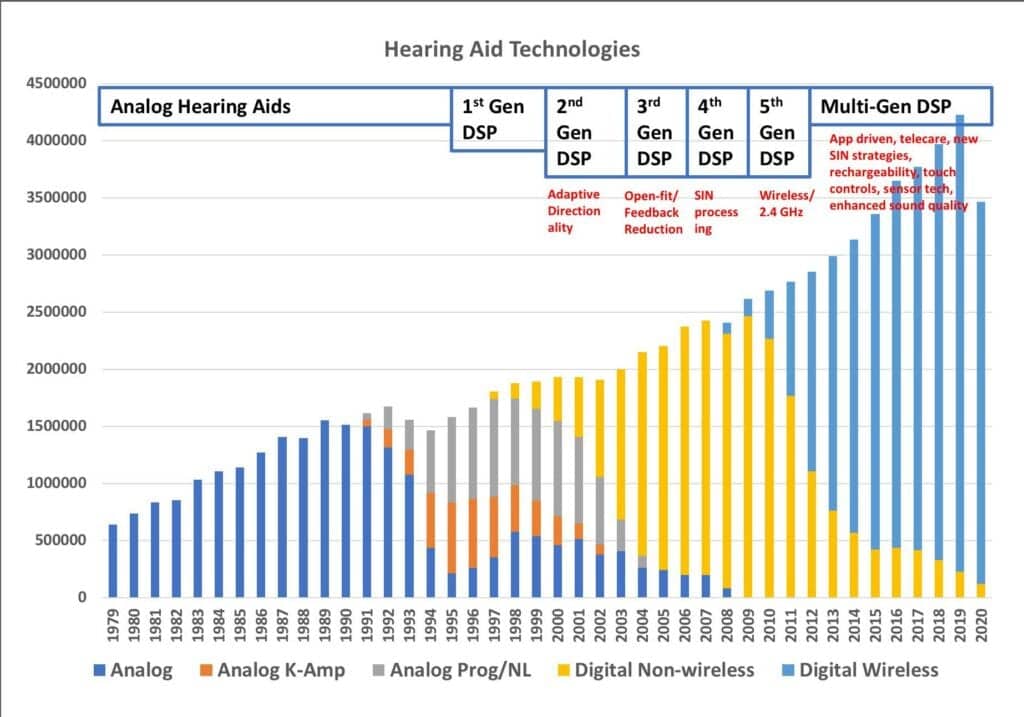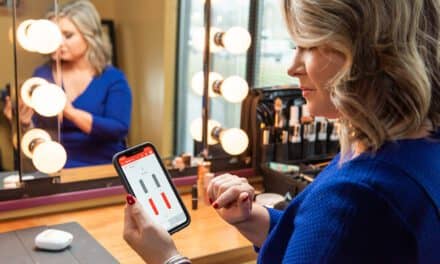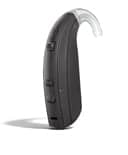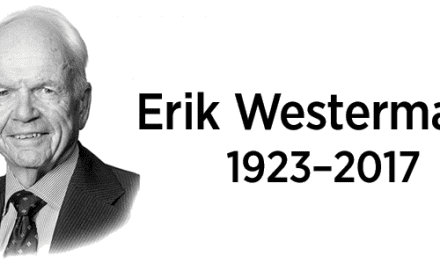By Karl Strom, editor
The technology and styles of hearing aids continue to evolve with new circuit and power capabilities, auditory research, and consumer preferences. With this evolution, consumers now have a wide range of choice in terms of hearing aid form factors, as well as wireless and connectivity options.

Figure 1 demonstrates the progression of hearing aid technologies since the late-1970s, using statistics from the Hearing Industries Association and numerous estimates by Hearing Review. Analog linear was the only technology available prior to the 1990s, although it did come in many forms and innovative alterations, which included numerous receiver options, alternatives for modifying tubing and venting, earmold and shell modifications, and different circuits. The results of some of this technology were mixed. For example, Hawkins and Naidoo found that linear peak-clipping circuits were used in 82% of all fittings in 1991, even though output compression circuits were an available option at the time. The hearing industry also tried to improve listening in different environments by changing the frequency response via potentiometers (eg, for rolling off low frequencies, clipping thresholds, etc) and toggle switches for users (eg, resonance peak controls). The Analog Hearing Aid Era also featured the genesis of several selection and fitting strategies, including the “Carhart method”, reliance on word lists (eg, CID-22 and NU-6), followed by numerous matrix methods and fitting rules like the Lybarger half-gain rule, Libby 1/3 and 2/3 rules, Cox/MSU, POGO, and NAL-R.
ASP and Digitally Programming Age
Automatic signal processing (ASP) started seeing widespread use in hearing aids during the early 1990s. For example, the Etymotic Research K-AMP used treble increase at low levels (TILL) processing that resulted in a level-dependent frequency response with the goal of providing more gain in the higher frequencies for quiet sounds (<40 dB), 2:1 compression for inputs from 40-90 dB, and a flat response for louder signals. In the mid-90s, HR estimates the K-AMP circuit was used in about 40% of all US hearing aids. It was also during this time that a widening array of acoustic parameters were controlled by physical switches and screwdrivers on the hearing aid—limited mostly by the space available for the engineers to cram them onto a faceplate.
Related Article: A Brief History of Hearing Aid Styles, 1991-2020
Although this article focuses on circuitry, it’s also easy to forget that custom ITEs made up more than 75% of the entire US market until the early 2000s—compared to today’s hearing aid market of 90% behind-the-ear (BTE) and receiver-in-the-canal (RIC) devices. Miniaturization of circuitry and batteries also made possible the introduction of the first completely-in-the-canal (CIC) hearing aids in 1994. It wasn’t until 2007 that BTEs and RICs combined to make up over half the market. Although directional microphones (DMs) had existed well before, the introduction in 1994 of the Phonak AudioZoom, a device that offered the ability to easily move from effective omni to directional modes, demonstrated the utility of DMs for improving speech understanding in noise.
Digitally programmable hearing aids—essentially analog circuits programmed with the help of digital computer software—were also developed during early 1990s, and greatly improved the selection and fitting options available to hearing care professionals. For the first time, clinicians and the industry were confronted with what to do with a hearing aid that contained scores of parameters with infinite adjustment possibilities for increasingly higher numbers of bands/channels. ReSound emerged as one of the first companies to excel in this new digitally controlled realm. As noted by the Independent Hearing Aid Fitting Forum (IHAFF) in 1994, the circuit technology was “outrunning” the research that could tell us how best to implement ASP and maximize amplification for audibility and speech perception, while maintaining user comfort. Of great importance in this time period were the development of wide dynamic-range compression (WDRC) circuits, as well as the various concepts surrounding WDRC.
Digital Signal Processing
Going back to the 1980s, it was clear to everybody that ASP and digitally programmable analog devices were only an intermediate step to digital signal processing (DSP) hearing aids. Although Bell Lab researchers had simulated digital amplification with large computers in 1967 and several attempts at developing a commercially viable DSP were made in the 1980s, the first DSP aids to do so were from Oticon (DigiFocus) and Widex (Senso) 25 years ago in 1996—and the technology was rapidly adopted by all major hearing aid manufacturers. When the first DSP hearing aids were introduced, there were 43 analog digitally programmable lines of hearing aids available; by the start of 1997, there were 7 companies offering DSP aids, and by 2001 there were 44 digital product lines. By 2009, the Hearing Industries Association (HIA) no longer even tracked analog technology because the unit volume numbers were so low.
Although each manufacturer’s DSP development obviously varied from each other, DSP aids went through several distinctive “generations” with similar themes. The first generation of devices were more-or-less a replication of analog digital programmable aids, except with enhanced software and fitting controls. Generations 2 and 3 tended to concentrate on new innovations in directional microphone responses and feedback control systems, with the latter paving the way for the ReSound Avance slim-tube BTE and the first receiver-in-the-canal (RIC) hearing aids by Sebotek that now dominate our industry. Generation 4 DSP devices mostly concentrated on new speech-in-noise enhancements and steady-state noise controls.
Wireless DSP Aids
Although several wireless technologies had been developed and implemented to connect hearing aids to cellphones, the ReSound Alera hearing aid was the first to use the 2.4 GHz wireless protocol in 2010. Universal connectivity to the internet and the cloud have become key goals in premium hearing aid offerings.
These wireless DSP aids, continue to expand the capabilities of hearing aids as sophisticated amplification devices, and are harkening in a new age of multifunctional devices connected to the Internet of Things. A hearing aid user can now make a phone call without touching their smartphone, and Personal assistants like Siri and Alexa can similarly be summoned for discreet use. Geolocation to assist with program selection and embedded motion sensors for improving listening situation identification, as well as fall detection, are now being implemented in hearing aids, along with language translation as demonstrated by the Starkey Livio. Linking the hearing aid to the constellation of wireless devices—although sometimes a pain for dispensing professionals who are being asked to become IT wireless connection experts in addition to hearing care professionals—is opening up vast new areas of functionality for hearing devices.
What Next?
It’s clear that the ultimate goal of hearing aid technology is to improve audibility, speech perception, and comfort in virtually any listening setting. Returning to Figure 1, 96% of the hearing aids dispensed in the United States during 2020 were digital wireless devices. So, what’s next?
Among the many possibilities are a new generation of AI-guided devices, expanded teleaudiology and “virtual hearing helpers,” new sensor technology for health and fitness monitoring, and more. However, it should also be remembered that the US hearing aid industry has been challenged by government entities like PCAST, NASEM, and FDA to increase accessibility and affordability. Thus, we are also likely entering an era that emphasizes greater choice in terms of technology levels, more products for mild or near-normal hearing levels, teleaudiology, and a wider range of pricing levels with financing options—like those offered by Ally Lending — that make hearing aids more accessible and affordable.
About the author: Karl Strom is editor of The Hearing Review and has been reporting on hearing healthcare issues for over 25 years. He wrote this article for the sponsored Ally Lending enewsletter.





